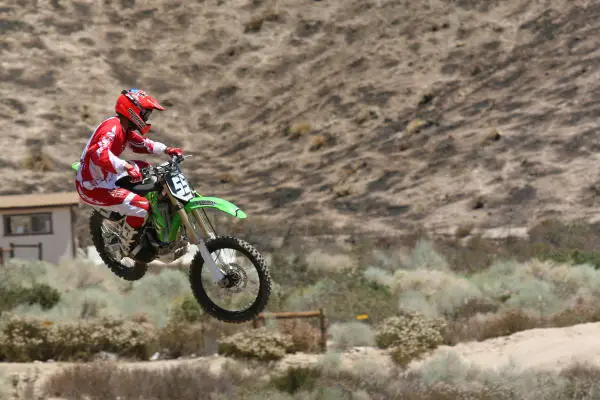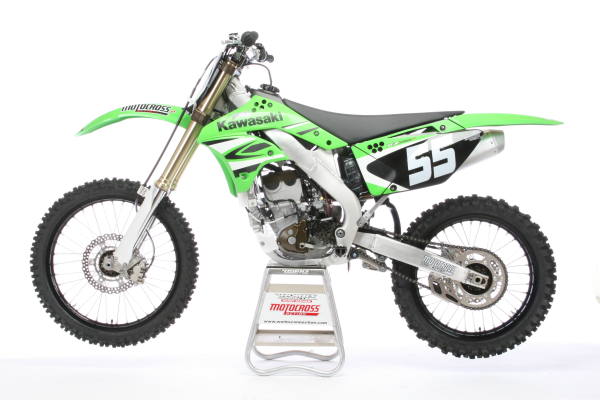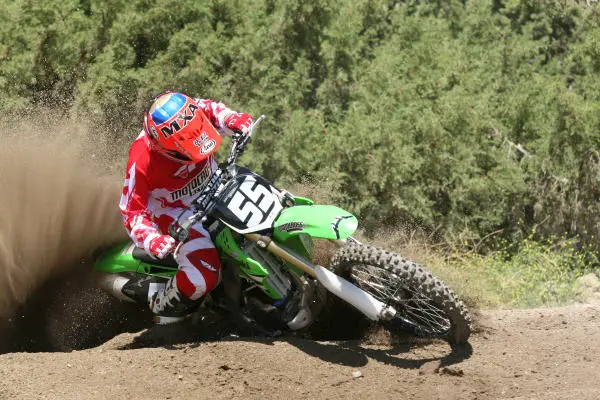2008 RACE TEST KAWASAKI KX250F
It would be easy for you to assume that the Honda CRF250 has ruled the 250cc four-stroke roost since its introduction in 2004, but nothing could be further from the truth. The real winners in the deuce-and-a-half thumper sweepstakes have been Yamaha and Kawasaki.
Yamaha invented the category in 2002 and owned it through 2005. When Suzuki, Kawasaki and Honda entered the fray in 2004, Yamaha steamrolled over the still-teething red, green and yellow competition. Then, in 2006, Kawasaki threw off the shackles of its alliance with Suzuki, which had the two companies sharing products, and kicked out the jams. Kawasaki caught everyone sleeping. Yamaha had become complacent in its dominance, Honda was struggling with reliability issues, and Suzuki BNG’ed its 2005 model for ’06. When all the shouting was done, Kawasaki had produced an engine that left the rest of the field wheezing. The KX250F hit hard in the middle and refused to give up on top.
In a class where horsepower is king, the 2006 KX250F became instant royalty. Based solely on its awesome powerband, Kawasaki stood on the top step of the 250 four-stroke fiefdom in 2006 and 2007. The question for the MXA wrecking crew was whether muscle would be enough to keep the KX250F on top in 2008.
Q:WHAT’S NEW ON THE 2008 KX250F?
A:Kawasaki’s engineers put moderate effort into the 2008 model.
Engine cases: The crankcases were made more rigid around the crankshaft and transmission input and output shafts. This is a reliability mod.
Kickstarter: The kick start ratchet was beefed up by 3.5mm for more consistent operation.
Tranny: A three-degree higher shift lever position helps the rider get his boot under the shifter more easily.
Head gasket: To lessen compression loss over time, Kawasaki switched to a higher-quality head gasket.
Muffler: The last few inches of the muffler’s “perf core” are unperforated for quieter operation.
Motor mount: Spacers were added to both sides of the front engine mount to lessen the torsional rigidity of the frame. This is a handling mod.
Suspension: The forks get a 0.5mm thicker piston rod and a new air bleed system to maintain compression damping at the end of the stroke. The shock is revalved, and the ride height has been raised in the rear for quicker handling.
Q:WHAT DOES THE 2008 KX250F ENGINE RUN LIKE?
A:The 2008 KX250F engine runs very much like the 2007 model, which wasn’t all that different from the 2006’s power profile. While the dyno curve follows the same arc, and the ’08 engine feels like a clone of the ’07, test riders felt that the 2008 was a tad softer from the midrange on up. The dyno confirmed the seat-of-the-pants opinion. Surprisingly, no test riders complained. The softness is not a deal-breaker. The KX250F engine hits hard at 7000 rpm, produces serious acceleration through the middle, and doesn’t give up through 13,000 rpm. This engine doesn’t hang, rev slowly or sign off. It’s a workhorse. The low-end isn’t much to write home about, but from seven grand on up the KX250F rips.
Q:IS IT STILL THE BEST ENGINE IN THE 250F CLASS?
A:Yes. It may not have the low-end surge of the RM-Z250, the manageability of the CRF250, the torque of the YZ250F or the linear smoothness of the 250SXF, but it makes up for that with a pure racing powerband. It hits hard and takes off. This is the best powerband in the class for a motorcycle racer.
What engine had a better powerband? The 2007 KX250F, but not by much.
Q:WHAT ARE THE BEST TRAITS OF THE 2008 KX250F?
A:There is one great attribute of the 2008 KX250F.
Power: If this bike was mellow, user friendly or torquey, it wouldn’t be half the machine it is. The placement of its power (mid-and-up), its rapid climb up the dyno chart (after 7000 rpm), and its healthy over-rev (to 13,000 rpm) overshadows everything else about the KX250F. If the 2008 KX-F had an average powerband, its multitude of niggling faults would dethrone it instantly.
This bike is all about power?nothing else.

Q:WHAT ARE THE FLAWS OF THE 2008 KX250F?
A:There are four significant problem areas on the ’07 KX250F.
Handling: It isn’t the best handling 250 four-stroke. That honor goes to the Suzuki RM-Z250?by leaps and bounds. Thankfully, Kawasaki’s tiny little fix to the front motor mount seems to have lessened Kawasaki’s traditional push in the center of the corner. Using a long bolt with spacers on each side of it (on the front of the engine), allows the front down tube to flex just enough to give the front end more grip. Kawasaki’s one-bolt fix may sound like a lot of hogwash, but the MXA test crew has ridden bikes where simply bolting on a skid plate stiffens up the chassis so much that cornering is ruined. All that aside, the KX250F could use more help from the center-out.
Shifting: The shift from second to third often ends up being a shift from second to second. Too much rev, not enough boot and a gusty head wind can result in missed shifts (especially the upshift to third). If you take your time it will shift perfectly, but taking your time isn’t what racing is all about. Moving the shift lever up three-degrees didn’t do doodly.
Gear ratios: No MXA test riders like the gap between second and third gear. It is a mighty leap for a 35-horsepower machine to make. The factory riders don’t complain about it because they use special one-off transmissions with closer gear ratios. We were forced to fix it with a different rear sprocket.
Wiring harness: Believe it or not, we had to replace the complete wiring harness on our 2008 KX250F at the four-hour mark. The bike would start, but it would not keep running. We changed every part until the Pro Circuit mechanics suggested replacing the wiring harness. That fixed it.
Q:WHAT CHANGES WOULD WE MAKE TO THE 2008 KX250F?
A:We have a list of changes that make the KX250F into a better machine.
Pro Circuit KX shock linkage: Forget about Kawasaki’s engineers raising the ride height at the rear: it has always been too high. Instead, switch to the shock linkage that Ryan Villopoto and Ben Townley run. It lowers the rear end by almost half an inch, changes the rising rate, and balances out the chassis. Best of all, it makes the rear shock stiffer in the first half of its stroke.
22mm offset triple clamps: We wholeheartedly believe in swapping the stock 24.5mm triple clamps for aftermarket 22mm clamps. This isn’t a pie-in-the-sky fix; this offset is used by every National class KX250F rider.
Gearing: Don’t even try to race the 2008 KX250F with the stock rear sprocket. It needs one more tooth to tighten up the generous gap that Kawasaki’s engineers put in there for trail riders.
Exhaust: In case we’ve failed to deliver our message clearly: the KX250F is all about horsepower (and nothing else). Swapping out the stock muffler for a race system will easily gain back the small amount that the KX250F lost with its new quiet muffler?plus some more to grow on.
Q:WHAT DID WE DO TO THE STOCK JETTING?
A:The stock pilot jet was too small, and if it’s too small in the heat of SoCal, it will only get worse in cooler climes. We upped the pilot from a 40 to a 42. This helped the starting and the low-to-mid transition.
Main: 170
Pilot: 42 (40 stock)
Needle: NJET
Leak jet: 50
Clip position: Fourth from top
Fuel screw: 1-1/2 turns out (1-3/4 stock)
Notes: The 2008 KX250F was sensitive on the fuel screw until we changed the pilot.
Q:HAS KAWASAKI FIXED THE HANDLING ON THE 2008 MODEL?
A:Yes and no. But let’s focus on the “yes” part. The 2008 KX250F isn’t as cranky at mid-turn as its brethren were. The fork valving, slightly steeper head angle (created by the taller ride height), flexier down tube and tire combo produce a more forgiving green streak. It isn’t as anxious to stand up in the center as it was?and that translates into more confidence.
It’s a good-handling bike. It’s a better-handling bike. It is not, however, a great-handling bike.
Q:HOW GOOD IS THE SHOWA SUSPENSION ON THE KX250F?
A:Unlike the KX450F, which uses Kayaba components, the KX250F is equipped with Showa parts. And while MXA test riders have been enamored with the Kayaba SSS stuff, we were impressed with the KX250F’s Showa setup.
We think that fast or heavy riders will bottom out on the compression clicks (both front and rear), but the average-size 250F rider will find settings that work very well.
Q:WHAT WAS OUR BEST FORK SETTING?
A:For hard-core racing we recommend this fork setup:
Spring rate: 0.44 kg/mm
Oil height: 310cc
Compression: Six clicks out
Rebound: Ten clicks out
Fork leg height: 5mm up
Notes: If you have to go more than six clicks out on compression, you will need to step up to the next stiffest spring rate.
Q:WHAT WAS OUR BEST SHOCK SETTING?
A:For hard-core racing we recommend this shock setup:
Spring rate: 5.4 kg/mm
Race sag: 100mm
Hi-compression: 1-1/4 turns out
Lo-compression: Six clicks
Rebound: Ten clicks
Notes: We think that the KX250F works best with the low-speed compression turned in, while using the high-speed to adjust the ride height at speed.
Q:WHAT DID WE HATE?
A:The hate list:
(1) Gearing: The quick fix is one tooth on the rear.
(2) Transmission: We knew we were in trouble when we heard that Kawasaki moved the shift lever. Why? Because that means that they knew they had a shifting problem, but could only afford a shift lever change in the R&D budget.
Q:WHAT DID WE LIKE?
A:The like list:
(1) Wheels: There is a caveat to the KX250F’s black rims. They look great on the showroom floor, but after a few tire iron dings and rock roost, they lose their luster.
(2) Handlebars: There is a healthy contingent of MXA test riders who still prefer 7/8-inch handlebars. The KX250F makes them feel at home.
(3) Radiator shrouds. The half black/half green radiator wings have been replaced with all-green units. We were torn about the cosmetic change, but never noticed the missing black parts after day one.
(4) Muffler. At AMA sound test levels, the 2008 KX250F checked in at 95.5 dB. That is quiet (the typical production bike is closer to 98 dB when new).
Q:WHAT DO WE REALLY THINK?
A:We like this bike. It’s got a powerband to die for. In the big picture, we think that Kawasaki made just enough changes to keep itself at the front of the pack. Just in front. That is a dangerous R&D policy, because you never know when the competition is going to kick out the jams?like Kawasaki did in 2006. o










Comments are closed.